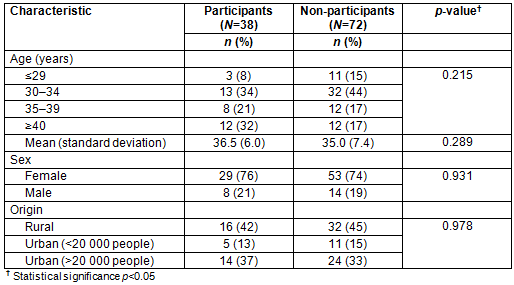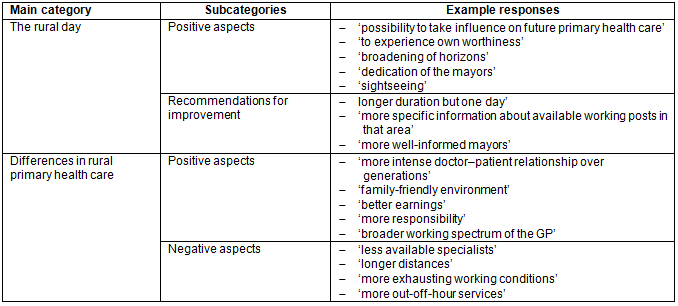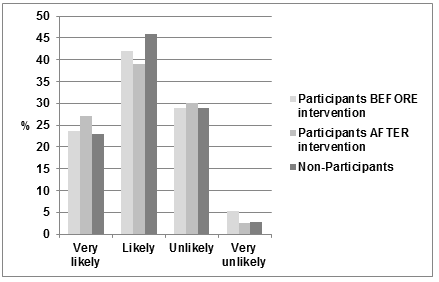'What the farmer doesn't know, he won't eat' - so goes a German proverb. This is a starting point for a widely used strategy to deal with general practitioner workforce shortages in rural areas: to offer contact with rural healthcare services during undergraduate or postgraduate training or to focus on applicants with a rural background1,2. The ideal duration and to what depth this contact should be offered is as yet unknown3,4.
In 2009, in the German federal state of Baden-Württemberg, a rotation network program was implemented offering structured GP postgraduate training. It is called the 'Verbundweiterbildungplus Baden-Württemberg' (Verbundweiterbildungplus)5. Currently, the Verbundweiterbildungplus offers high quality GP postgraduate training for more than 500 trainees by coordinating hospital and ambulatory training posts, including in rural areas6. It provides regular educational meetings within a competency-based curriculum7 and facilitates mentoring and cooperation with the Department of General Practice and Health Services Research at the University Hospital Heidelberg. From the beginning, the Verbundweiterbildungplus aimed to establish sustainable local rotation networks for GP postgraduate training, especially in rural areas6. Unfortunately, medical schools in Germany are not located in rural areas, and because the location of universities might be a barrier in providing rural health exposure to students8 we developed a concept to ensure rural health exposure for GP trainees.
Historically, Germany has had relatively little difference in access to health care throughout Germany and, compared to countries like Australia and Canada, has far fewer geographically rural areas9 . Furthermore, the number of physicians per capita is greater than in many other countries (3.8 vs 3.2 on average across OECD countries). However, more physicians are older than 55 years (40% vs 32% on average across OECD countries)10. German rural areas have a concerning shortage of general practitioners11.
The 'rural day' - an intervention
To give trainees an impression of the scarcity of rural and remote areas in Baden-Württemberg, a day trip to rural communities - the 'rural day' - was implemented to bring together rural communities with GP trainees. There were eight rural days in total across the state and the schedule of these days differed slightly due to local adaption and availability of actors in primary care. The Verbundweiterbildungplus program was presented, as well as evidence concerning strategies related to local GP shortages by political stakeholders such as mayors and district administrators. This was followed with information about the rural region with a focus on primary healthcare services and local characteristics (eg geographic location, infrastructure, industry and points of interests). Subsequently, there was time for informal discussions between GP trainees and political stakeholders in small groups. In the afternoon sessions, local primary healthcare centres with modern concepts of service delivery and local points of interests were visited.
The research question for the project was to determine whether the rural day was an effective intervention for GP workforce shortages in rural communities. This project report presents the outcome of the rural day: intention to work in a rural area.
To examine the effect of the rural day intervention on GP trainees, we conducted a cross-sectional study using a mixed-methods approach. At the time of the study, 500 GP trainees were enrolled in Verbundweiterbildungplus. Invitations to complete an internet-based questionnaire were distributed by email to the 274 GP trainees who had previously been asked to participate in one of eight rural days between 20 May 2011 and 13 January 2014. To increase participation, an email reminder was sent after 6 weeks.
A draft for the questionnaire was obtained from Landy et al8. This questionnaire was translated and culturally adapted by a group of researchers at the Department of General Practice and Health Services Research of the University Hospital Heidelberg. The questionnaire contained 4 generic and 10 specific items for participants in the rural day, and 4 specific items for non-participants. The generic items related to trainees' socio-demographic characteristics such as age, sex and origin. Questions relating to participants' overall and specific attitudes towards rural health care were included. The specific items for participants in the rural day contained questions regarding the intention to work in rural areas and the perception of health care delivered in rural regions before and after the rural day. Free text allowed the trainees to express personal opinions about what they liked or did not like about the rural day as well as ideas for improvement. The specific items for non-participants allowed them to specify reasons for non-participation. The German version of the questionnaire can be requested from the authors.
Participation in the survey was voluntary; by completing the questionnaire, the GP postgraduate trainees gave permission to publication of data. The survey was carried out anonymously.
The analyses were performed using the Statistical Package for the Social Sciences v20.0 (SPSS Inc., http://www.spss.com). First, a descriptive analysis was performed concerning the socio-demographic characteristics of the two groups, participants and non-participants. Categorical data were presented as frequency counts and percentages. For group comparison, χ2 test or student t-test were used depending on the distribution of data. The effect of participation in the rural day, operationalized with the categories of 'before' and 'after' participation, was analyzed using the non-parametric Wilcoxon-test within the group of participants. Non-parametric Mann-Whitney U-test with list-wise exclusion of missing data was used for group comparison. Multiple answers were analyzed regarding frequency of answers. An alpha level of p<0.05 was used for tests of statistical significance.
The data from the free text were treated as qualitative data and analyzed by two different researchers independently from each other. Data were categorized and a final consensus version was discussed by the two researchers. Key issues were identified, summarized, labeled as codes and sorted into main and subcategories based on the qualitative content analysis12. According to the rules of the qualitative content analysis the categories were developed near to the original material. Quotations from the free text were used to illustrate each of the categories12.
Ethics approval
Following § 15 section 1, Professional Code of Conduct of the State Medical Chamber of Baden-Württemberg (Berufsordnung Landesärztekammer Baden-Württemberg), for this survey no approval by an institutional research review board was needed13.
Of 500 GP trainees of the Verbundweiterbildungplus, 274 trainees had the offer to participate at a rural day. From the 80 trainees who participated at a rural day, 38 responded to the survey (response rate 48%). From the 194 non-participants, 72 filled in the questionnaire (response rate 37%). The overall response rate was 40%. Participants and non-participants did not differ significantly in age, sex and origin. Table 1 shows the characteristics of participants and non-participants in the rural day.
Before the rural day, 25 (66%) rural day participants considered it likely/very likely that they would work in a rural area in the future, while 13 (34%) considered it unlikely/very unlikely. After the rural day, 25 (66%) considered working in a rural area to be likely/very likely and 12 (33%) unlikely/very unlikely. There was no significant difference in the intention to work in a rural area before and after participation in the rural day. Of the 72 non-participants in the rural day, 48 (69%) considered working in a rural area in the future likely/very likely and 22 (32%) unlikely/very unlikely. These findings were not significantly different to those for the participants (Fig1). However, 18 (47%) participants claimed that the rural day changed their overall attitudes towards rural areas positively, 1 (3%) indicated negatively and 19 (50%) indicated no change in their perspective. Participants used the free text to specify what they liked about the rural day.
From the non-participants, 69 (96%) claimed that primary health care in rural areas differs from the urban setting. Prior to attending the rural day 33 (87%) participants claimed that primary health care in rural areas differs from urban settings and after the rural day the result was 29 (78%), although these results were not statistically significant. In the free text, these differences could be unpacked in more detail. A total of 47 of 72 (66%) non-participants and 14 of 38 (38%) participants affirmed that physicians should get specific training for rural areas, which differed significantly (p=0.005). Table 2 presents the main categories of these statements.
Non-participants were asked for reasons for non-attendance at the rural day. Table 3 shows the reason for non-participation; multiple answers were possible. A total of 22 (36%) non-participants claimed workplace reasons (eg 'no chance to take a day off'), 19 (31%) declared that they already knew where they would work in the future and 17 (27%) claimed personal reasons (eg 'no child day care'). In the free text, several GP trainees stated that they were 'at the beginning of training' and participating at the rural day was not relevant for them at their stage of training, but 'later in training it would be definitely interesting'.
Table 1: Profiles of general practice trainee rural day participants and non-participants

Table 2: General practice trainees' views about rurality

Table 3: Reasons for rural day non-participation by general practice trainees (multiple answers)


Figure 1: General practice trainees' intentions to work in rural areas in the future.
Discussion
The results of the project showed that a simple intervention such as a single rural day can improve the attitude towards rural areas in general. In our sample, this was almost 50% of the survey participants. However, the outcome 'intention to work in a rural area' remained largely unchanged within the group of participants and this did not differ significantly from the non-participants' perspectives. These findings are concordant with an intervention among first-year medical students in Florida8.
Participants and non-participants agreed strongly that primary health care in rural areas differs from the urban setting, but significantly more non-participants recommended that doctors should get special (continuing) medical education for rural areas. Possibly, participation at the rural day did show participating GP trainees that they were able to provide sufficient care without needing additional 'rural care' training.
GP trainees valued the possibility to have an influence on future developments, and recognized the dedication and appreciation of stakeholders, but would have valued more time with them than offered. These may be important aspects in tailoring future interventions by focusing on autonomy and self-confidence of GP trainees and extending the contact to rural areas, for example by facilitating rotations in rural training posts. As shown in other countries, decentralized GP postgraduate training in rural communities may be an effective approach for recruiting and retaining general practitioners in rural areas1,14,15. Furthermore, integrating stakeholders and politicians informed about local needs and possibilities is of great importance; some participants criticized some mayors for being not well informed.
Overall, participants see the work of a rural general practitioner positively: enhanced doctor-patient relationship over generations, and family-friendly environment and better earnings, which confirms previous studies16,17. Nevertheless, participants highlighted negative aspects of primary care in rural areas, for example more exhausting working conditions and longer distances to travel, as well as more after-hour services. These concerns could be addressed by reducing primary care physicians' workloads, for example by implementing health information technology and advancing the role of non-physician practice staff18,19, and through training schemes for general practitioners. According to a survey in Germany, 90% of mayors consider it their responsibility to guarantee primary health care in rural areas20. A rural day may be an opportunity for rural communities to get in contact with potential future general practitioners. The significance of the shortage of rural general practitioners also may not be fully recognized yet by key stakeholders with responsibility for workforce decisions and by trainers, as 35% of non-participants stated workplace reasons for non-attendance at the rural day.
Several non-participating trainees declared the rural day was not relevant for them at their stage of training. This underlines the necessity to offer such days on a regular, longitudinal basis and to perhaps even make attendance obligatory.
A main strength of this study was that the Verbundweiterbildungplus has had many years of experience and expertise in organizing rural days: it was the first program to introduce and evaluate this intervention in Germany. The response rate of 40% met international standards in surveys among general practitioners21,22. Rural day participants and non-participants did not differ regarding socio-demographic data. A limitation of this study is the limited number of participants in the survey, even though an email reminder was sent after 6 weeks to increase participation. Furthermore, as the survey was carried out in Baden-Württemberg among GP trainees from Verbundweiterbildungplus, this sample may include a bias towards trainees with above-average motivation.
A rural day as an intervention against GP workforce shortages changes the view of rural areas positively, but has no influence on the intention to work there. More awareness and responsibility regarding the critical development in rural primary health care among political stakeholders, trainers and trainees is desirable. To increase the impact of the intervention, participation should be obligatory and duration should be extended. A rural day should be complemented by rotations in rural practices. Advantages of working in rural areas were recognized by GP trainees; therefore, these benefits should be given more emphasis during training. Possible barriers towards working in rural areas should be adequately addressed by political stakeholders as well as GP training programs.
Acknowledgements
This project was supported by the Baden-Württemberg Ministry of Science, Research and Art; the Ministry of Rural Area, Alimentation and Consumer Protection; and the Ministry of Labour and Social Affairs, Families, Women and Senior Citizens, Stuttgart, Germany.
References
1. Henry JA, Edwards BJ, Crotty B. Why do medical graduates choose rural careers? Rural and Remote Health (Internet) 2009; 9: 1083. www.rrh.org.au (Accessed 21 November 2014).
2. Natanzon I, Szecsenyi J, Ose D, Joos S. Future potential country doctor: the perspectives of German GPs. Rural Remote Health (Internet) 2010; 10(2): 1347. Available: www.rrh.org.au (Accessed 21 November 2014).
3. Ranmuthugala G, Humphreys J, Solarsh B, Walters L, Worley P, Wakerman J, et al. Where is the evidence that rural exposure increases uptake of rural medical practice? Australian Journal of Rural Health 2007; 15(5): 285-288.
4. Wyatt D. Implementing a professional development framework for rural and remote doctors. In: AB Chater, J Rourke, ID Couper, RP Strasser, S Reid (Eds.). WONCA rural medical education guidebook. (Internet) 2014. Available: http://www.globalfamilyldoctor.com (Accessed 21 November 2014).
5. Steinhaeuser J, Roos M, Haberer K, Ledig TH, Peters-Klimm F, Szecsenyi J, Joos S. The program ?Verbundweiterbildung plus' in Baden-Württemberg [Das Programm Verbundweiterbildung plus des Kompetenzzentrums Allgemeinmedizin Baden-Württemberg - Entwicklung, Umsetzung und Perspektiven]. Zeitschrift für Evidenz, Fortbildung und Qualität im Gesundheitswesen 2011; 105: 105-109.
6. Steinhaeuser J, Annan N, Roos M, Szecsenyi J, Joos S. Approaches to reduce shortage of general practitioners in rural areas - results of an online survey of trainee doctors [Lösungsansätze gegen den Allgemeinarztmangel auf dem Land - Ergebnisse einer Online-Befragung unter Ärzten in Weiterbildung]. Deutsche Medizinische Wochenschrift 2011; 136: 1715-1719.
7. Steinhaeuser J, Chenot JF, Roos M, Ledig T, Joos S. Competence-based curriculum development for general practice in Germany: a stepwise peerbased approach instead of reinventing the wheel. BMC Research Notes 2013; 6: 314.
8. Landy DC, Gorin MA, Egusquiza JD, Weiss J, O'Connell MT. Medical student attitudes before and after participation in rural health fairs. Journal of Research in Medical Sciences 2012; 17(3): 298-303.
9. Steinhaeuser J, Otto P, Goetz K, Szecsenyi J, Joos S. Rural area in a European country from a health care point of view: an adaption of the Rural Ranking Scale. BMC Health Services Research 2014; 14: 147.
10. OECD. Health at a glance 2013: OECD indicators. (Internet) 2013. Available: http://dx.doi.org/10.1787/health_glance-2013-en (Accessed 21 November 2014).
11. Scheidt L, Joos S, Szecsenyi J, Steinhaeuser J. Oversupplied? Undersupplied? - the perspective of local governments of the federal state of Baden-Württemberg: a contribution to the discussion of close-to-home health care [Überversorgt? Unterversorgt? - die Sicht von Bürgermeistern in Baden-Württemberg: Ein Beitrag zur Diskussion um die wohnortnahe medizinische Versorgung]. Gesundheitswesen 2015; 77: 1-2.
12. Krippendorff K. Content analysis. An introduction to its methodology. Beverly Hills: Sage, 1980.
13. Krippendorff K. Professional code of conduct of State Medical Chamber of Baden-Württemberg [Berufsordnung Landesärztekammer Baden-Württemberg]. (Internet) 2012. Available: https://www.aerztekammer-bw.de/10aerzte/40merkblaetter/20recht/05kammerrecht/bo.pdf (Accessed 30 January 2014).
14. Robinson M, Slaney GM. Choice or chance! The influence of decentralised training on GP retention in the Bogong region of Victoria and New South Wales. Rural and Remote Health (Internet) 2013; 13: 2231. Available: www.rrh.org.au (Accessed 21 November 2014).
15. Ross R. Fifteen-year outcomes of a rural residency: aligning policy with national needs. Family Medicine 2013; 45(2): 122-127.
16. Goetz K, Musselmann B, Szecsenyi J, Joos S. The influence of workload and health behavior on job satisfaction of general practitioners. Family Medicine 2013; 45(2): 95-101.
17. Kreiser B, Riedel J, Völker S, Wollny A, Richter C, Himmel W, et al. New practice set-up of family practitioners in rural Mecklenburg-Western Pomerania - a qualitative study [Neuniederlassung von Hausärzten im ländlichen Mecklenburg-Vorpommern - eine qualitative Studie]. Zeitschrift für Allgemeinmedizin 2014; 90(4): 158-164.
18. Fisher ES. Building a medical neighborhood for the medical home. New England Journal of Medicine 2008; 359(12): 1202-1205.
19. Urban E, Ose D, Joos S, Szecsenyi J, Miksch A. Technical support and delegation to practice staff - status quo and (possible) future perspectives for primary health care in Germany. BMC Medical Informatics and Decision Making 2012; 12: 81.
20. Steinhäuser J, Scheidt L, Szecsenyi J, Goetz K, Joos S. Perceptions of the local government about the primary care physicians shortage - a survey among mayors in the federal state of Baden-Württemberg [Die Sichtweise der kommunalen Ebene über den Hausärztemangel - eine Befragung von Bürgermeistern in Baden-Württemberg]. Gesundheitswesen 2012; 74(10): 612-617.
21. Bonevski B, Magin P, Horton G, Foster M, Girgis A. Response rates in GP surveys - trialling two recruitment strategies. Australian Family Physician 2011; 40(6): 427-430.
22. Winona Pit S, Hansen V, Ewald D. A small unconditional non-financial incentive suggests an increase in survey response rates amongst older general practitioners (GPs): a randomised controlled trial study. BMC Family Practice 2013; 14: 108.
